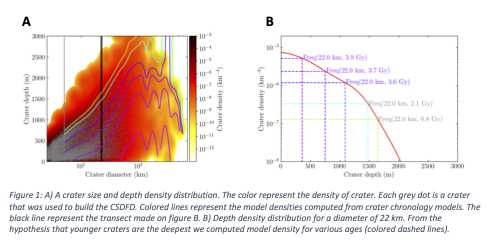Estimating crater obliteration rate through crater depth statistics
- 1Université Claude Bernard, Villeurbanne, France
- 2CRPG, Université de Loraine, Nancy, France
- 3GLOBE institute, University of Copenhagen, Copenhagen, Denmark
Introduction
Impact craters are widely used to investigate the geologic history of planetary surfaces. For example, their morphology bears clues on past surfaces processes that affected the surface such as erosion, sedimentary deposit and volcanic processes. One of the most interesting use of impact craters is the dating of planetary surfaces using their size frequency distribution (Hartmann and Neukum 2001; Stöffler and Ryder 2001; Young 1940). This method has been used in almost every study that provide an age for geologic bodies other than Earth.
If lunar crater size frequency distributions are most often pristine, craters on many other bodies are degraded over time. Hence crater size frequency distributions often present a depletion of small craters compared to the lunar ones. Mars is a good example of this phenomenon that has been named Opik effect (Opik 1966). Taking into account crater degradation when dating planetary surface will not only improve this method, but also provides new insights into the geological processes which resulted in the crater degradation.
In this study we combine statistic and morphology of craters in order to investigate the timing and intensity of surface processes. We introduce the notion of crater size and depth frequency distributions, adding a dimension to classic size and depth frequency distribution. Using crater chronology models, those crater size and depth frequency distributions can be interpreted in term of crater depth depletion speed that we refer as crater obliteration.
Method
Craters populations are already widely referenced. On Mars, Robbins & Hynek, 2012 proposed a huge crater database that they estimate complete down to 1 km of diameter. In this database, most craters above 6 km of diameter are provided with a morphology. We computed crater depth from the elevation of the floor and the median elevation of the rims.
Crater size and depth frequency distribution are then constructed using probability density distribution as recommended by Robbins et al., 2018. Each crater is convoluted by a 2D gaussian determined by the analytical error on the measured depth and diameter.
Assuming that the deepest craters are the freshest ones, we used crater chronology models (Ivanov 2001; Neukum, Ivanov, and Hartmann 2001) to associate a depth for each diameter and age (Figure 1). For each diameter, we then derivate depth according to age to compute obliteration.
We observe strong noise at the limit of the distribution, that cause an increase in computed obliteration for recent ages. This is caused by the spreading of the crater size and depth frequency distribution beyond the observed craters as a result of convolution. To remove this bias, we only keep obliterations measured when the model number of crater is more than 5.

Results
From Robbins & Hynek, 2012 crater databases, we computed crater size and depth frequency distribution for geologic areas of Mars simplified from the geologic map of Tanaka et al., 2014. We computed obliteration rates from those
We presents here the obliterations rates obtained for 3 Martian geologic areas, namely the Southern Highland, Tharsis Province and the Hesperian lowlands, that illustrate our main results.
Only the most cratered surfaces, such as the Southern Highlands present a number of craters large enough to investigate Noachian obliteration rates (Figure 2). During this era, obliteration rates reach several thousands m/Gy, but rapidly decrease during early Hesperian and are close to 0 during Amazonian.
Volcanic provinces such as Tharsis, Isidis and Elysium present obliterations rates more important than the rest of the planet during Hesperian. This suggest that our method is sensitive to volcanic activity. We show here the example of the province of Tharsis (Figure 3), where obliteration rates decreased slower than on the rest of the planet, suggesting a persistence of volcanic activity until early Amazonian.
Northern lowlands witness Amazonian obliteration rates one order of magnitude higher than the rest of the planet (Figure 4). This observation is still under further investigation, but may suggest a continuous emplacement of geologic material during middle Amazonian which may be related to Vastitas Borealis Formation.
We have developed a new method to model crater distribution and degradation taking into account of the size and depth of impact craters. Using this model, we were able to retrace the variations of crater obliteration through Martian era, and provide insight into the geological processes dominating crater degradation. The method with additional inputs from crater depths provides novel insights into the geological processes dominating crater degradation at different epochs in Martian history. Combined with higher resolution datasets, this method has potential to be applied to understand regional geological processes on Mars and other planetary bodies.
Bibliography
Hartmann, William K., and Gerhard Neukum. 2001. “Cratering Chronology and the Evolution of Mars.” Space Science Reviews 96(1–4): 165–94.
Ivanov, Boris A. 2001. “Mars/Moon Cratering Rate Ratio Estimates.” Space Science Reviews (November 2000).
Neukum, Gerhard, Boris A. Ivanov, and William K. Hartmann. 2001. “Cratering Records in the Inner Solar System in Relation to the Lunar Reference System.” Space Science Reviews 96(1–4): 55–86.
Opik, E. J. 1966. “The Martian Surface.” Science 153(3733): 255–65. http://www.sciencemag.org/cgi/doi/10.1126/science.153.3733.255.
Robbins, Stuart J. et al. 2018. “Revised Recommended Methods for Analyzing Crater Size-Frequency Distributions.” Meteoritics and Planetary Science 53(4): 891–931.
Robbins, Stuart J., and Brian M. Hynek. 2012. “A New Global Database of Mars Impact Craters ≥1 Km: 1. Database Creation, Properties, and Parameters.” Journal of Geophysical Research E: Planets 117(5): 1–18.
Stöffler, D., and G Ryder. 2001. “Stratigraphy and Isotope Ages of Lunar Geologics Units: Chronological Standard for the Inner Solar System.” : 9–54.
Tanaka, Kenneth L. et al. 2014. “Geologic Map of Mars.” USGS.
Young, J. 1940. “A Statistical Investigation of Diameter and Distribution of Lunar Craters.” Journal of the British Astronomical Association.
How to cite: Breton, S., Quantin-Nataf, C., and Pan, L.: Estimating crater obliteration rate through crater depth statistics, Europlanet Science Congress 2020, online, 21 September–9 Oct 2020, EPSC2020-823, https://doi.org/10.5194/epsc2020-823, 2020

